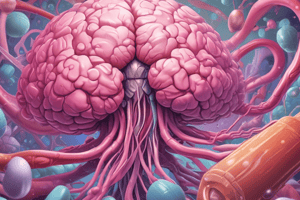Podcast
Questions and Answers
What is the primary function of an antineoplastic drug?
What is the primary function of an antineoplastic drug?
- To provide pain management for cancer patients
- To relieve cancer symptoms
- To treat cancer by preventing or slowing the growth of cancer cells (correct)
- To diagnose cancer
Which type of antineoplastic drug damages DNA and prevents cell division?
Which type of antineoplastic drug damages DNA and prevents cell division?
- Hormonal agents
- Alkylating agents (correct)
- Antitumor antibiotics
- Antimetabolites
What is the mechanism of action of antimetabolites?
What is the mechanism of action of antimetabolites?
- They inhibit DNA synthesis and cell growth (correct)
- They inhibit hormone-dependent tumor growth
- They stimulate the immune system to fight cancer
- They damage DNA and prevent cell division
Which type of antineoplastic drug is used to treat hormone-dependent tumors?
Which type of antineoplastic drug is used to treat hormone-dependent tumors?
What is the mechanism of action of targeted therapies?
What is the mechanism of action of targeted therapies?
What is one of the mechanisms by which antineoplastic drugs work?
What is one of the mechanisms by which antineoplastic drugs work?
What is a common side effect of antineoplastic drugs?
What is a common side effect of antineoplastic drugs?
Through which route can antineoplastic drugs be administered?
Through which route can antineoplastic drugs be administered?
What can lead to resistance to antineoplastic drugs?
What can lead to resistance to antineoplastic drugs?
Why is regular monitoring of treatment response and side effects important?
Why is regular monitoring of treatment response and side effects important?
What is an example of a type of antineoplastic drug?
What is an example of a type of antineoplastic drug?
Study Notes
Definition
An antineoplastic drug is a medication used to treat cancer by preventing or slowing the growth of cancer cells.
Classification
Antineoplastic drugs can be classified into several categories:
- Alkylating agents: damage DNA and prevent cell division (e.g. cyclophosphamide, busulfan)
- Antimetabolites: interfere with DNA synthesis and cell growth (e.g. methotrexate, 5-fluorouracil)
- Antitumor antibiotics: inhibit DNA synthesis and cell growth (e.g. doxorubicin, bleomycin)
- Plant-derived agents: inhibit cell growth and division (e.g. paclitaxel, vinblastine)
- Hormonal agents: inhibit hormone-dependent tumor growth (e.g. tamoxifen, leuprolide)
- Targeted therapies: inhibit specific molecular targets involved in cancer growth and progression (e.g. trastuzumab, imatinib)
- Biologic response modifiers: stimulate the immune system to fight cancer (e.g. interferon, interleukin-2)
Mechanisms of Action
Antineoplastic drugs work through various mechanisms, including:
- Inhibiting cell proliferation
- Inducing apoptosis (cell death)
- Inhibiting angiogenesis (new blood vessel formation)
- Enhancing immune response
- Inhibiting DNA repair
Side Effects
Antineoplastic drugs can cause a range of side effects, including:
- Myelosuppression (bone marrow suppression)
- Nausea and vomiting
- Hair loss
- Fatigue
- Increased risk of infection
- Organ damage
Administration
Antineoplastic drugs can be administered through various routes, including:
- Oral
- Intravenous
- Intramuscular
- Subcutaneous
- Topical
Resistance and Toxicity
Antineoplastic drugs can lead to resistance and toxicity due to various factors, including:
- Genetic mutations
- Gene amplification
- Increased efflux pumps
- Dose-related toxicity
- Organ damage
Monitoring and Dose Adjustment
Regular monitoring of treatment response and side effects is crucial to adjust doses and minimize toxicity. This includes:
- Blood cell counts
- Liver and kidney function tests
- Tumor marker assessments
- Imaging studies
These notes provide an overview of antineoplastic drugs, their classification, mechanisms of action, side effects, administration, resistance, and toxicity, as well as the importance of monitoring and dose adjustment.
Definition
- Antineoplastic drugs are medications used to treat cancer by preventing or slowing the growth of cancer cells.
Classification
- Alkylating agents damage DNA and prevent cell division, e.g. cyclophosphamide, busulfan.
- Antimetabolites interfere with DNA synthesis and cell growth, e.g. methotrexate, 5-fluorouracil.
- Antitumor antibiotics inhibit DNA synthesis and cell growth, e.g. doxorubicin, bleomycin.
- Plant-derived agents inhibit cell growth and division, e.g. paclitaxel, vinblastine.
- Hormonal agents inhibit hormone-dependent tumor growth, e.g. tamoxifen, leuprolide.
- Targeted therapies inhibit specific molecular targets involved in cancer growth and progression, e.g. trastuzumab, imatinib.
- Biologic response modifiers stimulate the immune system to fight cancer, e.g. interferon, interleukin-2.
Mechanisms of Action
- Inhibiting cell proliferation.
- Inducing apoptosis (cell death).
- Inhibiting angiogenesis (new blood vessel formation).
- Enhancing immune response.
- Inhibiting DNA repair.
Side Effects
- Myelosuppression (bone marrow suppression).
- Nausea and vomiting.
- Hair loss.
- Fatigue.
- Increased risk of infection.
- Organ damage.
Administration
- Oral administration.
- Intravenous administration.
- Intramuscular administration.
- Subcutaneous administration.
- Topical administration.
Resistance and Toxicity
- Genetic mutations can lead to resistance and toxicity.
- Gene amplification can lead to resistance and toxicity.
- Increased efflux pumps can lead to resistance and toxicity.
- Dose-related toxicity.
- Organ damage can lead to toxicity.
Monitoring and Dose Adjustment
- Blood cell counts are used to monitor treatment response and side effects.
- Liver and kidney function tests are used to monitor treatment response and side effects.
- Tumor marker assessments are used to monitor treatment response.
- Imaging studies are used to monitor treatment response.
- Regular monitoring is crucial to adjust doses and minimize toxicity.
Studying That Suits You
Use AI to generate personalized quizzes and flashcards to suit your learning preferences.
Description
Learn about antineoplastic drugs used to treat cancer, their types, and how they work to prevent or slow cancer cell growth.




